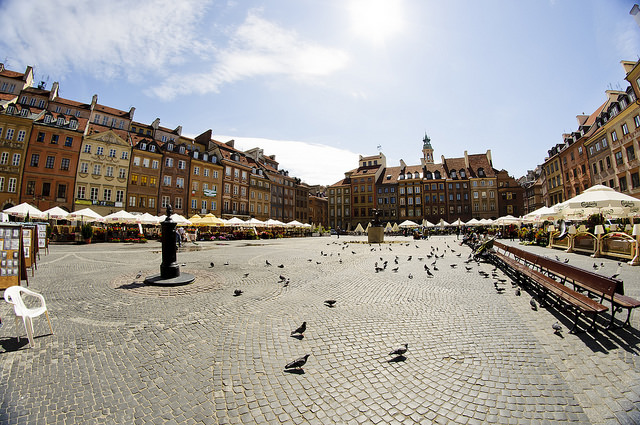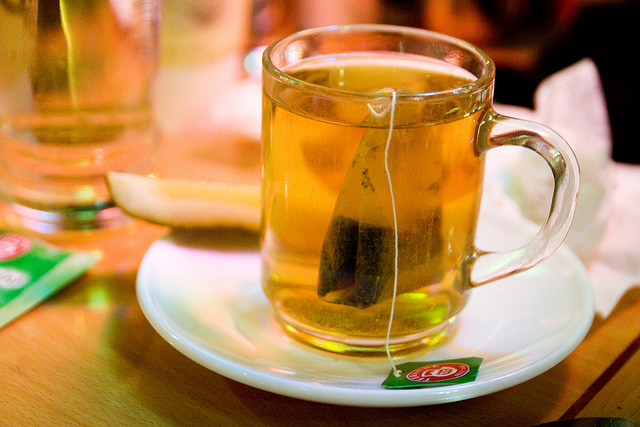In my experience, your average western European, even if they happen to know a lot about the world in general, tends to think of Poland as of a fairly uniform country. “Surely they all speak that same funny rustling language, love Warsaw their capital, and, to put it mildly, have developed a strong aversion towards Germany.” No true at all – and high time to debunk a myth or two.
In medias res then! Who are the warring parties today? On the one side of the barricade there’s my hometown of Katowice, standing vicariously for the whole of Silesia and the inhabitants of that region, who are popularly referred to as hanysy (worry you not, all these mysterious pseudonyms will be explained in due course), bravely repelling an incursion of combatant number two – the hordes of gorole, in this case represented by Warsaw, the Polish capital.

The Polish capital Warsaw
So let’s prepare the metaphorical battlefield. If Warsaw probably needs little or no introduction (“Well, we are the capital after all”), then names like Katowice and Silesia may sound less familiar to you. This shouldn’t worry you unduly. Famously, when the then British Prime Minister David Lloyd George heard the word Silesia at the Versailles conference back in 1919 he thought they were discussing Cilicia (the south coastal region of Asia Minor). In very general terms, Silesia is a historic region in Central Europe. Nowadays it is almost entirely located within the boundaries of Poland, with small bits of it extending into the Czech Republic and Germany. Historically, it has been divided into two parts, Lower Silesia (Niederschlesien) with Wrocław (Breslau) as its centre, and Upper Silesia (Oberschlesien), with Katowice (Kattowitz). Rather confusingly, Lower Silesia is the northwestern part and Upper Silesia the southeastern, almost exactly the opposite of what their names seem to suggest.
“Ganz richtig fojne Nimcy”
You may have noticed that in brackets we have provided the German names. What’s the point? This is where history steps in and the first and arguably also most decisive casus belli is to be found. To simplify matters a bit, the Polish King Casimir the Great relinquished Silesia as early as 1337. The first new owners were the rulers of Bohemia. Their successors were Austrians and Prussians. Parts of Upper Silesia returned to Poland only after the First World War. The rest – after the Second World War. During the centuries that elapsed in the meantime, Silesia developed in isolation from the rest of Poland. Events like the Polish expansion into the east and Poland’s subsequent spectacular decline, marked by partitions and uprisings, were not part of Silesia’s identity. Instead, the region grew in symbiosis with the German-speaking world, and the consequences of that are still very much felt today. Several decades cannot obliterate marks imprinted by the course of centuries, as I will demonstrate with a couple of intentionally exaggerated examples.

A Silesian skyline
For starters, you can already guess that in Katowice/Kattowitz and generally in Silesia we have no phobia of the Germans. On the contrary, we have the concept of ganz richtig fojne Nimcy – rather quite nice Germany. (If you know German, you might recognise “ganz” and “richtig” and think Polish must have plenty of German words. You are partially right – there are indeed many Germanisms, but the phrase is in Silesian, not Polish. Another casus belli which we shall discuss in a second.) In rural areas of Silesia – which were considerably less affected by post-war immigration – German surnames are as common or maybe even more common that Slavonic ones. When I visit the small village where my grandparents live, I play football with Jonietz, Kutscher, Weinzettel, Buhl, Wiesbach to name but a few. Talking about football: do names like Miroslav Klose and Lukas Podolski sound at least vaguely familiar? Yes, the legendary strikers; for many years, mainstays of the German national football team. Born in Poland, their families emigrated to Germany when they were both very young. When they are interviewed by Polish journalists they both reply in Polish, but with a very marked Silesian accent.
Even the younger generations of people living in Silesia are still fairly competent in their very distinct dialect that centuries of German and to a lesser extent also Czech influence have caused to differ considerably from standard Polish. Let’s quote just a few examples of German words that have entered Silesian, contrasted with their equivalents in Polish: ajgentor (own goal / gol samobójczy), torman (goalkeeper / bramkarz), giwera (gun / strzelba), glajzy (railway tracks / tory kolejowe). If you add to this the differences in pronunciation and grammar it’s not a surprise that standard Polish speakers often struggle to understand Silesians. Even when they speak standard Polish many Silesians still retain some salient non-standard features in the way they sound. My own experience bears this out. Back in 2010, I spoke (in Polish) with a famous Polish economist Leszek Balcerowicz who asked me what I was studying. German with Czech and Slovak, was my answer. Balcerowicz’s reply came as a shock (or did it?): “Oh, so Oxford is a great place to study Slavonic languages. You are doing Czech and Slovak and additionally I can hear you speak fairly good Polish as well. You’re German, are you not?” Indeed.
An evergreen conflict
Time to explain one secret from the beginning. In Silesian, hanys denotes a native inhabitant of Upper Silesia, whereas gorol is anybody from any other part of Poland (and I should add that this word is almost exclusively used pejoratively, just like the adjective gorolski – not just “foreign”, but downright “inferior”…). A particularly notorious subtype of the gorol is the warszawiok – an inhabitant of our beloved capital, the embodiment of all vices, especially disorganisation, slow-wittedness, and, well, laziness. This last characteristic of a warszawiok is thematised in a well-known joke: soon after parts of Silesia returned to Poland, a warszawiok meets a hanys and says: “Now we’ll teach you how to speak proper Polish!” The hanys acknowledges the warszawiok‘s superior command of standard Polish, but is not easily ruffled and delivers a counter that leaves his adversary speechless: “Yes – and in return we’ll teach you what work is all about.”
Ever since gorole and hanysy began living together once more in one state, their coexistence has always been somewhat strained
Ever since gorole and hanysy began living together once more in one state, their coexistence has always been somewhat strained. Half in earnest, half tongue in cheek, it’s because “the Warsaw regime” considers Silesian an unreliable, Germanophile element. A couple of years ago (incidentally, around the same time as my conversation with Professor Balcerowicz – with hindsight I am asking myself whether there may have been a connection…?), the leader of the then main opposition party in the Polish parliament said that all the people who consider themselves Silesians were in fact “a camouflaged German option”. This was not a statement by some fringe individual – but by somebody who to this day remains one of the key figures on the Polish political stage (and, last but not least, a born warszawiok…!). But what on earth did he mean exactly? Who ought to be considered “a camouflaged German”? According to Polish Nonsensopedia (a satirical version of Wikipedia), you fit the bill if you:
- live in Katowice and not in Warsaw;
- you eat kartofle (potatoes – from the German Kartoffeln) rather than ziemniaki;
- you play fusbal rather than piłka nożna when you fancy a kick-about;
- on TV you watch the szpil (game – from the German Spiel) rather than the mecz;
- you tend to watch RTL or ZDF (both German TV channels) rather than Telewizja Trwam (a nationalist and Catholic Polish TV channel)
And finally if you start your day with a glass of tyj (tea – from the German Tee) rather than herbata, you may be accused of betraying the Polish national interest. So I’d better not tell anybody…

Tyj or herbata, that is the question…
In the years between 2000-2009, Polish television aired a comedy series set in Katowice. The main character Hubert Dworniok (family names ending in ‘-ok’ are typical of Silesia) and his wife are native Silesians, his best friend Zbyszek is however from Warsaw. Together they attempt many a plan of a truly audacious scope. Perhaps predictably – given that they cooperate “across the frontier” – those plans usually go wrong, sometimes spectacularly so, giving Hubert and Zbyszek plenty of reasons to blame each other, and of course they never fail to take advantage of the many biases and stereotypes that surround their native cities. The series had a very fitting title – Święta wojna, which means “The Holy War”. A war that always ended in a truce.
So long live Silesia and its capital Katowice, where the people say “No matter who wins today – Germany or Poland – we won’t lose”. And cheers to the warszawioki as well – our perennial adversaries, whose ideas of Polishness never cease to amaze us.
Cover photo: włodi (Flickr); Licence: CC BY-SA 2.0





